The open source Anti-Spam SMTP Proxy Server for Mac project was designed to create a platform-independent SMTP Proxy server that implements auto-whitelists, self learning Bayesian, Greylisting, DNSBL, DNSWL, URIBL, SPF, SRS, Backscatter, Virus scanning, attachment blocking, Senderbase and multiple other filter methods. This tutorial will provide information on how to configure Firefox on your Mac to use our HTTP proxy servers which can be found here. Click 'Preferences' 3. Go to the Advanced tab and select the Network tab and then Settings. Select 'Manual proxy configuration' and input the HTTP proxy Server address from our list here. Check “Secure Web Proxy (HTTPS)” checkbox (7).In the “Secure Web Proxy Server” field (8) type the IP address of the CactusVPN proxy server you want to connect to and enter the Port number you want to use. Click on “OK” (9). You may be asked to enter your Mac user password. Enter it (10) and click on “Always Allow” (11). Check the box for 'Web Proxy (HTTP)' and enter the IP address for your SecureSchool appliance, and the correct proxy port. Do the same for 'Secure Web Proxy (HTTPS)'. Click 'OK' to save and close the proxy settings, then click 'Apply' to save and close the Network properties.
Http Proxy For Mac Os 10.12

Mac OS X does a good job of juggling proxy configurations for graphical applications while moving between wired and wireless network connections. However, this functionality doesn’t extend to command-line work in Terminal or iTerm and can be a pain when using git or package managers like npm, apm, pip, or homebrew while switching between environments. This post describes a method for programmatically setting the command-line network proxy environment variables based on the configured proxy in the Network System Preferences pane.
Mac OS X Proxy Behavior
Mac OS X maintains individual network proxy settings for each network adapter. For example, a Thunderbolt ethernet adapter has its own proxy configuration associated with it that is separate from a wireless adapter. The operating system uses the proxy configuration for the currently-connected adapter, updating the system proxy as adapter connection states change. If more than one adapter is connected, the operating system uses the proxy configuration for the connected adapter highest on the adapter list in the Network System Preferences pane. The adapter order can be changed by clicking on the gear icon at the bottom of the list and clicking the “Set Service Order…” menu item.

Access System Proxy settings in Terminal

The scutil command-line utility allows for management for a variety of system configuration parameters and can be used to access system proxy configuration with the --proxy flag.
Here is the output of scutil --proxy without a configured proxy:
and here is the output of scutil --proxy with example.proxy set as the system proxy for the HTTP and HTTPS protocols:
Parse scutil output
We can use awk to parse the output of scutil and extract the proxy configuration. The following snippet does the trick:
This script looks for HTTPEnable, HTTPProxy, and HTTPPort in the output of scutil. If the proxy is enabled, the script prints out the proxy URL and sets it as the http_proxy environment variable. If the proxy is not enabled, the script sets http_proxy to an empty string. The final line sets the HTTP_PROXY environment variable as well since some command-line applications use that instead.
Placing this snippet in your .bash_profile ensures that your proxy will stay configured automatically while switching between wired and wireless networks.
Mac OS is quite a popular operating system, which is famous for its smooth operation, reliability and speed. But if you switch from Windows OS to Mac, at first sight it will not be clear and it will be difficult to deal with all the settings. Therefore, we have prepared a manual for you on how to set up a proxy server in MAC OS.
First you need to open the Apple menu and select “System Preferences”.
Next, select “Network” from the list.
After that, select your Ethernet or Wi-Fi connection from the list in the right menu and click “Advanced”.
From the top menu, select “Proxies” and check the “Web proxy (HTTP)” checkbox and enter your proxy and port on the right side. If the proxy requires a login and password for authorization, enter it below.
Mac System Proxy
Then switch to “Secure Web Proxy (HTTPS)” and make the same settings.
If you need to connect SOCKS Proxy, do the same thing as http and https.
Mac Proxy Software
Next, click “OK” and “Apply”. That’s where the settings are finished. You can open your browser and use the Internet.